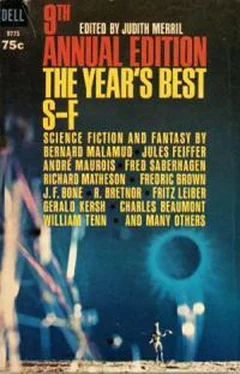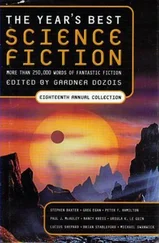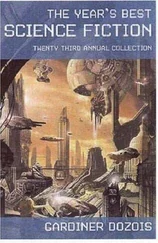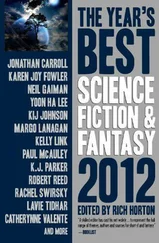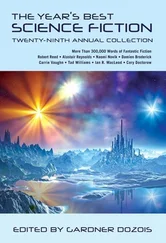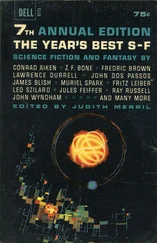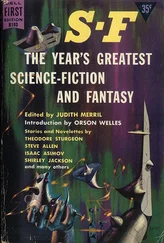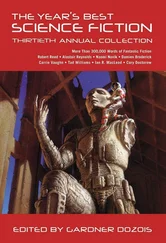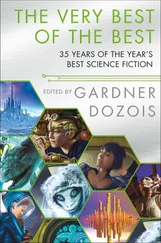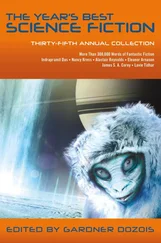The Year's Best Science Fiction 9
Здесь есть возможность читать онлайн «The Year's Best Science Fiction 9» весь текст электронной книги совершенно бесплатно (целиком полную версию без сокращений). В некоторых случаях можно слушать аудио, скачать через торрент в формате fb2 и присутствует краткое содержание. Год выпуска: 1965, Издательство: Dell, Жанр: Фантастика и фэнтези, на английском языке. Описание произведения, (предисловие) а так же отзывы посетителей доступны на портале библиотеки ЛибКат.
- Название:The Year's Best Science Fiction 9
- Автор:
- Издательство:Dell
- Жанр:
- Год:1965
- ISBN:нет данных
- Рейтинг книги:5 / 5. Голосов: 1
-
Избранное:Добавить в избранное
- Отзывы:
-
Ваша оценка:
- 100
- 1
- 2
- 3
- 4
- 5
The Year's Best Science Fiction 9: краткое содержание, описание и аннотация
Предлагаем к чтению аннотацию, описание, краткое содержание или предисловие (зависит от того, что написал сам автор книги «The Year's Best Science Fiction 9»). Если вы не нашли необходимую информацию о книге — напишите в комментариях, мы постараемся отыскать её.
The Year's Best Science Fiction 9 — читать онлайн бесплатно полную книгу (весь текст) целиком
Ниже представлен текст книги, разбитый по страницам. Система сохранения места последней прочитанной страницы, позволяет с удобством читать онлайн бесплатно книгу «The Year's Best Science Fiction 9», без необходимости каждый раз заново искать на чём Вы остановились. Поставьте закладку, и сможете в любой момент перейти на страницу, на которой закончили чтение.
Интервал:
Закладка:
Fifteen or twenty of the poems in the Updike volume qualify readily as s-f; I liked, in particular, “Cosmic Gall,” “In Praise of (C l0H fO s)V “While Dwarf,” “Comp. Religion,” “Fever,” and the title poem, “Telephone Poles.”
Aniara is the book of poems on which the Swedish space opera (no joke; opera, about space) of the same name is based. The opera was published here in 1962; the poems in 1963.
In addition to these, several individual poems came to my (delighted) attention during the year: John Ciardi’s “A New Fable of the Grasshopper and the Ant,” in McCall’s; May Swenson’s “Models of the Universe,” written on commission for the Steuben Glass Company; Doris Pitkin Buck’s “No Trading Voyage,” in Fantasy and Science Fiction/ Robert Cullen’s “Dolphin,” in Commonweal) “Helpmeet,” by “Sec,” in the Reporter) J. S. Bigelow’s “The Bat and the Scientist,” in the Atlantic Monthly.
I come now to the paragraph where I must thank those people who assisted in the preparation of the anthology. This (like the securing of stories) is increasingly difficult: the number of people who offer suggestions, read stories, or lend clerical help, seems to grow with each book. With apologies, then, to the many who are not mentioned here— my especial gratitude to Carol Emshwiller and Anthony Boucher for their recommendations; to Virginia Blish, Gerard Dorion, and James Walker for reader reactions; to Mary Lou Collard, Marcia Pley, George Roeder, and Ann Pohl, for clerical and other assistance; and above all to Barbara Norville, at Simon and Schuster, for every conceivable kind of help and cooperation.
The following authors participated in the Playboy symposium, the Double Bill survey, and/or the New Worlds guest-editorial series:
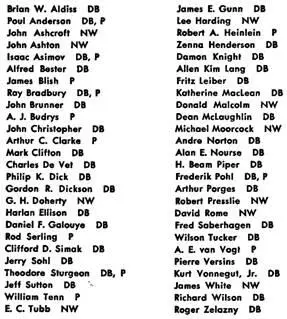
The following editors, anthologists, publishers, producers, etc., also participated! John W. Campbell, Jr., E. J. Cornell, Groff Conklin, Basil Davenport, Martin Greenberg, J. F. McComas, P. Schuyler Miller, all In Double Bill; Dr. I. F. Clarke and Roberta Rambelli, in New Worlds.
BOOKS
Anthony Boucher
Remember 1953? More Than Human, Bring the Jubilee, The Space Merchants, The Lights in the Sky Are Stars .. . hell, even the titles of science-fiction novels were more memorably exciting in that so recent and so remote aureate age. Today a reviewer receives an unending series of machine-made and all but indistinguishable paperback novels of the spaceways among which even the “lesser” novels of 1953 (remember The Syndic? or The Green Millennium?) would shine like novae.
But 1963 still had its own distinctions, few but marked. It was the year in which Robert A. Heinlein favored us with not one but two book-length stories, and it was the year in which Anthony Burgess entered the s-f field.
The first 1963 Heinlein, and one of his best in many years, was Podkayne of Mars (Putnam’s; Avon), a shrewd and successful effort to widen the s-f audience by a teen-age heroine. Poddy’s first-person narrative reveals her as a genuinely charming girl (perhaps the most delightful young female in s-f since Isaac Asimov’s Arkady Darell), and her creator as the master absolute of detailed indirect exposition of a future civilization. Just to prove that Heinlein can do anything, his later Glory Road (Putnam’s) is an all-out swashbuckling swords-and-sorcery, yellow-brick-road adventure tale, and a splendid one—at least until, as has happened before with Heinlein, the philosophy outlasts the plot and the book bogs down in overt lecturing.
Anthony Burgess’s A Clockwork Orange (Norton) is one of the most remarkable of s-f debuts: a penetrating novel of the next century’s juvenile delinquency, brilliant enough in its insights into the nature of crime and free will, but made doubly dazzling by the fact that it is related entirely in the nadsat (teen-age) jargon of the future—a curious slang so vividly compelling that you find yourself thinking in it for weeks afterward. Burgess’s later The Wanting Seed (Norton), on the theme of the population explosion, is more conventional, but still offers plentiful evidence that this is a mainstream writer who can create genuine s-f while writing with astonishing wit, grace, and distinction.
Of the year’s other novels the most noteworthy was Kurt Vonnegut, Jr.’s, Cat’s Cradle (Holt, Rinehart & Winston), a mad caprice which combines mad-scientist-destruction-of-earth with the swinging antireligion of Bokononism to create a freewheeling vehicle that may not take you anywhere but gives you an unforgettable ride.
Anthologies, which have been largely regrettable in recent years, brightened considerably in 1963, with several unusual specialized collections. The often unreliable “my favorite story” gimmick comes off well in Robert P. Mills’s The Worlds of Science Fiction (Dial), largely because of the inclusion of interesting writers not strictly “in the field” (Mark Van Doren, George P. Elliott, R. V. Cassill, and others). L. Sprague de Camp’s Swords and Sorcery (Pyramid) is so well edited (and so well illustrated by Virgil Finlay) as to delight the most die-hard resisters to heroic fantasy. D. R. Benson’s The Unknown and (in early 1964) The Unknown Fire (both Pyramid) are well-selected samplers from that greatest of fantasy magazines, Unknown Worlds. Damon Knight’s First Flight (Lancer) offers the first published stories (1937—1956) of ten of today’s leading s-f writers) and as with Mystery Writers of America’s similar collection. Maiden Murders (Harper, 1952), it’s amazing how good these novice efforts are.
Suggestion for a parlor game: Name the Big Name science-fiction authors whose careers began with the following sentences:
Nick looked at the cop, and the cop looked at Nick.
The chairman rapped loudly for order.
It was “The Seashell.” It would have to be “The Seashell.”
Margaret reached over to the other side of the bed where Hank should have been.
On and on Coeurf prowled!
Volumes of one-author short stories included the first collection of the work of Kate Wilhelm, The Mile-Long Spaceship (Berkley) and more of the charming nostalgic time-fantasies of Jack Finney, I Lore Gales-burg in the Springtime (Simon & Schuster). Who Fears the Devil? (Arkham) is a complete collection of Manly Wade Wellman’s rich and idiomatic folktales of John the Ballad Singer (from Fantasy and Science Fiction). S-f, in its broad sense, turns up in a few of The Stories of William Sansom (Atlantic-Little, Brown), in Evan Hunter’s Happy New Year, Herbie (Simon and Schuster), and in Graham Greene’s A Sense of Reality (Viking), especially in Greene’s “Under the Garden,” an extraordinary novelette on the nature of fantasy-and-reality. Readers who last year discovered Jorge Luis Borges may relish the comparably un-classifiable tales in Tommaso Landolfi’s Gogol’s Wife, translated by Raymond Rosenthal and others (New Directions).
Enthusiasts of H. P. Lovecraft could welcome two distinguished volumes: Collected Poems (Arkham), admirably illustrated by Frank Utpatel, and The Dunwich Horror and Others (Arkham; abridged. Lancer)—an ideal introduction to H.P.L., especially for August Derleth’s fine critical-biographical essay.
Читать дальшеИнтервал:
Закладка:
Похожие книги на «The Year's Best Science Fiction 9»
Представляем Вашему вниманию похожие книги на «The Year's Best Science Fiction 9» списком для выбора. Мы отобрали схожую по названию и смыслу литературу в надежде предоставить читателям больше вариантов отыскать новые, интересные, ещё непрочитанные произведения.
Обсуждение, отзывы о книге «The Year's Best Science Fiction 9» и просто собственные мнения читателей. Оставьте ваши комментарии, напишите, что Вы думаете о произведении, его смысле или главных героях. Укажите что конкретно понравилось, а что нет, и почему Вы так считаете.
